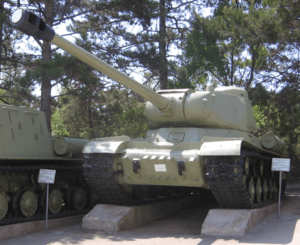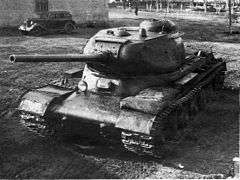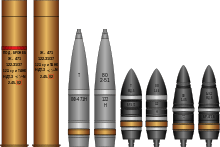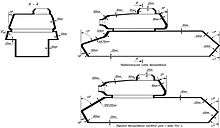IS-1 and IS-2
The IS-1, redesignated the IS-2 for security reasons, is the first Soviet heavy tank model of the IS tank series. It saw combat in World War II as well as service in other Soviet allied countries after the war.
| IS-2 | |
|---|---|
 IS-2 Model 1943, in Sevastopol. | |
| Type | Heavy tank |
| Place of origin | Soviet Union |
| Service history | |
| Used by | |
| Wars | |
| Production history | |
| Designer | Zhozef Kotin Nikolay Dukhov |
| Designed |
|
| Manufacturer | Kirov Factory, UZTM |
| Unit cost | IS-2 Model 1944: 264,400 rubles[1] |
| Produced |
|
| No. built |
|
| Specifications (IS-2 Model 1944[2]) | |
| Mass | 46 tonnes (51 short tons; 45 long tons) |
| Length | 9.90 m (32 ft 6 in) |
| Width | 3.09 m (10 ft 2 in) |
| Height | 2.73 m (8 ft 11 in) |
| Crew | 4 |
| Armor | IS-2 Model 1944: Hull front: 100 mm at 60° angle Lower glacis: 100 mm at 30° angle Turret front: 100 mm (rounded) Mantlet: 155 mm (rounded) Hull side: 90–130 mm at 9-25° Turret side: 90 mm at 20° angle. |
Main armament | D25-T 122 mm gun (28 rounds) |
Secondary armament | 1×DShK, 3×DT (2,079 rounds) |
| Engine | 12-cyl. diesel model V-2 600 hp (450 kW) |
| Power/weight | 13 hp/tonne |
| Suspension | torsion bar |
| Fuel capacity | 820 l (180 imp gal; 220 US gal) |
Operational range | 240 km (150 mi) |
| Maximum speed | 37 km/h (23 mph) |
Design and production
Object 237 KV-85 and IS-85/IS-1

The KV-1 was criticized by its crews for its poor mobility and the lack of a larger caliber gun than the T-34 medium tank. It was much more expensive than the T-34, without having greater combat performance. Moscow ordered some KV-1 assembly lines to shift to T-34 production, leading to fears that KV-1 production would be halted and the SKB-2 design bureau, led by Kotin, closed.[3] In 1942, this problem was partially addressed by the KV-1S tank, which had thinner armor than the original, making it lighter and faster. It was competitive with the T-34 but at the cost of no longer having the heavier armor. Production of the KV-1S was gradually replaced by the SU-152[4] and ended in April 1943.[5]
The capture of a German Tiger tank in January 1943 led to a decision to develop a new heavy tank, which was given the codename Object 237.[6] Before Object 237 had time to mature, intense tank fighting in the summer of 1943 demanded a response. Dukhov's team was instructed to create a stopgap KV tank, the KV-85, which was armed with the 52-K-derivative gun of the SU-85, the 85 mm D-5T, that proved capable of penetrating the Tiger I from 1,000 m (1,100 yd). The KV-85 was created by mounting an Object 237 turret on a KV-1S hull. To accommodate the Object 237 turret, the KV-1S hull was modified, increasing the diameter of the turret ring with fillets on the sides of the hull. The radio operator was replaced with an ammunition rack for the larger 85 mm ammunition. The hull MG was then moved to the opposite side of the driver and fixed in place to be operated by the driver. From September to October 1943, a total of 130 KV-85s were produced, before the assembly lines began to shift over. Like the KV-1S, the KV-85 served in dwindling numbers and was quickly overshadowed by the superior IS series.[7]
The Object 237 prototype, a version of the cancelled KV-13, was accepted for production as the IS-85 heavy tank.[8] First deliveries were made in October 1943, and the tanks went immediately into service. Production ended in January 1944. Its designation was simplified to IS-1 after the introduction of the IS-122, later renamed as IS-2 for security purposes.
Object 240 IS-2
Gun
By 1943, engineers had succeeded in mounting the 85 mm gun to the T-34 medium tank, making it as well-armed as the KV-85 heavy tank. Efforts to up-gun the IS-85 began in late 1943. Two candidate weapons were the D-25 122 mm tank gun, the ballistic characteristics of which were identical to the A-19 122 mm gun,[9] and the D-10 100 mm gun, which was based on a naval dual-purpose gun. The D-10 had been designed for anti-tank fire and had better armor penetration than the A-19, but the smaller caliber meant it had a less useful high explosive round. Also, the D-10 was a relatively new weapon in short supply, while there was excess production capacity for the A-19 and its ammunition. Compared to the older F-34 76.2 mm tank gun, the D-25 delivered 5.37 times the muzzle energy.
After testing both the D-25 and D-10 on the IS-122, the former was selected as the main armament of the new tank. The D-25 used a separate shell and powder charge, resulting in a lower rate of fire compared to the single-piece ammunition used in most tanks, a serious disadvantage in tank-to-tank engagements. Soviet proving-ground tests showed that the D-25 could penetrate the front armor of the German Panther at 2,500 m (2,700 yd) while the D-10 could do so at a maximum range of 1,500 m (1,600 yd).[9][10] It was therefore considered an adequate anti-tank gun. First deliveries of IS-122s mounted with this gun were in December of 1943.[11]

A Wa Pruef 1 Report dated 5 October 1944 has data on the penetration ranges of the 122 mm A-19 gun against a Panther tank angled at 30 degrees; this estimated that the A-19 gun was unable to penetrate the upper glacis plate of the Panther from any distance, could penetrate the lower glacis plate from 100 m (110 yd), could penetrate the mantlet from 500 m (550 yd) and could penetrate the front turret from 1,500 m (1,600 yd).[12] The Panther's 40–50 mm (1.6–2.0 in) thick side armor would have been exposed and vulnerable at such an angle; the sides at 30 degrees were penetrable from over 3,500 m (3,800 yd) according to the same Wa Pruef 1 report.[12] Testing with captured Tiger Ausf Bs in Kubinka showed that the 122 mm D-25T was capable of penetrating the Tiger Ausf B's turret from 1,000–1,500 m (1,100–1,600 yd) and the weld joint or edges of the front hull plates at ranges of 500–600 m (550–660 yd).[13] In 1944, the BR-471 was the sole armor-piercing round available. An improved version, the BR-471B (Russian: БР-471Б) was developed in spring 1945, but was available in quantity only after World War II ended.[14]
According to the same Wa Pruef 1 report, it was estimated that at 30 degree obliquity the hull armor of the Soviet IS-2 model 1943 would be defeated by Tiger I between 100 and 300 m (0.062 and 0.186 mi) at the driver's front plate and nose,[15] while the IS-2's 122 mm gun would penetrate the Tiger's front armor from between 500 and 1,500 m (0.31 and 0.93 mi).[15] A Panther had to close to 600 m (660 yd) to guarantee penetration of the IS-2's frontal armor (The Panther's 75 mm gun could penetrate the IS-2 model 1943's mantlet from 400 m (440 yd), front turret from 800 m (870 yd), and driver's front plate from 600 m (660 yd)[16]), while the IS-2 could penetrate the Panther at ranges of 1,000 m (1,100 yd).[17][Notes 1] However, in the summer of 1944, the Germans experienced a shortage of manganese and had to switch to using high-carbon steel alloyed with nickel, which made armor very brittle, especially at the seam welds. The performance of the 122 mm AP shells of the IS-2 against the Panther improved considerably. The reports from the front described cases where the BR-471 APHE round 122 mm projectile fired from 2,500 m (2,700 yd) ricocheted off the front armor of a Panther, leaving huge breaches to it.[11] According to Steven Zaloga, the IS-2[17] and Tiger I could knock each other out in normal combat distances below 1,000 m (1,100 yd). At any range, the performance of each tank against each other was dependent on the crew and combat situation.[18]

The large 122 mm HE shell was its main asset, proving highly useful and destructive as an infantry-killer. In extremis, the IS-2 engaged enemy heavy armor with OF-471 (Russian: ОФ-471) high explosive projectiles. These shells had a mass of 25 kg (55 lb), a muzzle velocity of 800 m/s (2,600 ft/s), and were equipped with a 3.8 kg (8.4 lb) TNT charge. The explosive power could blow off an enemy tank turret, drive sprocket and tread off the heaviest German tank even if it could not penetrate the armor.[19][19][20][20] Mechanical shock and explosion was often enough to knock out enemy heavy tanks.[19]
The most recognizable disadvantage of the D-25T gun was its slow rate of fire due to the large size and weight of the shells; only one to one and a half rounds per minute could be fired, initially.[21] After some design improvements, including a semi-automatic drop breech over the previously manual screw breech, the rate of fire increased to 2–3 rounds per minute.[21] According to other sources, the increase may have amounted to 3–4 rounds per minute.[22] Another limitation imposed by the size of its ammunition in a relatively small vehicle was the ammunition stowage: only 28 rounds could be carried inside the tank, with a complement of 20 HE rounds and 8 AP rounds the norm.[23][24]
Production
The IS-122 prototype replaced the IS-85 and began mass production as the IS-2. The 85 mm guns could be reserved for the new T-34-85 medium tank and some of the IS-1s built were rearmed before leaving the factory and issued as IS-2s. It was slightly lighter and faster than the heaviest KV model 1942 tank, with thicker front armor and a much-improved turret design. The tank could carry thicker armor than the KV series, while remaining lighter, due to the better layout of the armor envelope. The KV's armor was less well-shaped and featured heavy armor even on the rear, while the IS series concentrated its armor at the front. The IS-2 was slightly heavier than the Panther, much lighter than the Tiger I and Tiger II and had a lower silhouette than both. Western observers tended to criticize Soviet tanks for their lack of finish and crude construction. The Soviets argued that it was warranted, considering the need for wartime expediency and the typically short battlefield life of their tanks.[25]

Early IS-2s can be identified by the 'stepped' front hull casting with its small, opening driver's visor. The early tanks lacked gun tube travel locks or anti-aircraft-capable machine guns and had narrow mantlets.
In late 1944, the stepped hull front was replaced with an improved single casting of 120 mm thickness angled at 60 degrees. This new nose lacked the opening driver's visor. It is sometimes incorrectly referred to as the IS-2M, but that designation actually refers to a much later modernization program from the 1950s. Other minor upgrades included the addition of a travel lock on the hull rear, wider mantlet and, on very late models, an anti-aircraft machine gun.
In comparison to the Tiger I, the IS-2 had modest advantages in armour, even though it was 10 tons lighter[26] In 1944, IS-2 tank was the only large-scale Allied tank whose armor provided some protection from the well-known Tiger 88mm long-barreled guns and Panther 75mm L/70 guns.
In the mid-1950s, the remaining IS-2 tanks (mostly model 1944 variants) were upgraded to the IS-2M standard, which introduced fittings such as external fuel tanks on the rear hull (the basic IS-2 had these only on the hull sides), stowage bins on both sides of the hull and protective skirting along the top edges of the tracks.
Combat history
The IS-2 tank first saw combat in early 1944, equipping elite Guards Heavy Tank Regiments of the Red Army. First encountered by Otto Carius and a fellow Tiger I. After knocking out a column of T-34's, Carius moved into the nearby village of Malinava where he came face to face with the new IS-2. It was quickly destroyed, however as Carius moved further into the village he discovered a platoon of eight IS-2s. Carius and the 2nd Tiger dispatched all eight tanks without a loss. This was due to the fact that in order to reload the IS’s 122mm canon, the barrel had to be lowered to allow a new shell to be inserted into the breach. A regiment had 21 IS-2 tanks in four companies of five tanks each and one being used by the regimental commander.[27] The special tank regiments were reserved for important attacks, often to spearhead attempts to break through fortified German positions like anti-tank defence lines and bunkers.[27] The tanks supporting infantry in the assault by destroying bunkers, buildings, dug-in weapons and engaging German armoured vehicles. Once a breakthrough was achieved, lighter and more mobile tanks were used for exploitation and mopping-up. The IS-2 tank first saw action in Ukraine in early 1944 and claimed to have destroyed more than forty Tigers and Elefants for the loss of only eight tanks. While the German heavy tanks could knock out the IS-2, they had no real answer to its 122 mm gun, which easily outgunned them.[28]
Oględów
On the morning of 11 August 1944, the 16th Panzer Division attacked the 53d Guards Tank Brigade reinforced by the 71st Independent Guards Heavy Tank Regiment in the town of Oględów, toward Staszów. The extremely sandy terrain forced the eleven King Tigers to keep to the roads, whilst the defending Soviet forces positioned their tanks and assault guns in ambush positions and concentrated on the known German avenues of approach.[29] When the attack started, three Tiger IIs were destroyed by fire from Soviet IS-2 tanks and one more Tiger II was knocked out a few hours later by a T-34/76 at a range of less than 400 meters. Later in the day, Soviet forces counter-attacked and seized the town of Oględów and found three abandoned Tiger IIs. The capture of these tanks allowed the Soviets to conduct tests at Kubinka and to evaluate its strengths and weaknesses.[30]
Over the next two days the Red Army advanced on Staszów and in several counter-attacks, Heavy Tank Battalion 501 lost seven more Tiger IIs. Virtually all of these were destroyed by Soviet tanks occupying a defensive position against those German attacks.[30] In three days of fighting, Soviet forces destroyed or captured 14 of 30 Tiger IIs to an approximately equal number of Soviet IS-2s and T-34s.[30][31]
Post World War II
By the 1950s, the emergence of the main battle tank concept—combining medium-tank mobility with the firepower and armor of the heavy tank—had rendered heavy tanks obsolete. In the late 1960s the remaining Soviet heavy tanks were transferred to Red Army reserve service and storage. The IS-2 Model 1944 remained in service much longer in the armies of Cuba, China and North Korea. A regiment of Chinese IS-2s was available for use in the Korean War but saw no service there.
After the Korean War, China attempted to reverse-engineer the IS-2/IS-3 as the Type 122 medium tank. The project was cancelled in favor of the Type 59, a copy of the Soviet T-54A
Variants
- KV-85
- A stopgap model built from a modified KV-1S hull mated to an Object 237(IS-1)'s turret and armed with the 85 mm D-5T.[32]
- IS-85 (IS-1)
- 1943 model armed with an 85 mm gun. When IS-2 production started, many were re-gunned with 122 mm guns before being issued.
- IS-100
- A prototype version armed with a 100 mm gun; it went into trials against the IS-122 which was armed with a 122 mm gun. Though the IS-100 was reported to have better anti-armor capabilities, the latter was chosen due to better all-around performance.
- IS-122 (IS-2 model 1943)
- 1943 model, armed with A-19 122 mm gun.
- IS-2 model 1944 (sometimes "IS-2m")
- 1944 improvement with D25-T 122 mm gun, with faster-loading drop breech and new fire control, improved simpler hull front.
- IS-2M
- 1950s modernization of IS-2 tanks.
Operators
- People's Liberation Army: 60 IS-2s delivered in 1950–1951. Operated during the Korean War and in concrete bunkers along the Sino-Soviet border.
- Cuban Army: 41 IS-2Ms delivered in 1960.
- Czechoslovak Army: 8 IS-2/IS-2M in service between 1945-1960.
- NVA: 60 IS-2 delivered 1956. Operated until 1963.
- Hungarian People's Army: At least one IS-1 captured during the World War II, and 68 IS-2s in service between 1950-1956. After the crackdown of the Hungarian Revolution of 1956 all were returned to the Soviet Union.[34]
- Korean People's Army: Small number of IS-2s; never deployed in combat in the Korean War.
- Polish Land Forces: Approximately 71 IS-2s used in combat between 1944-1945. 180 IS-2s survived as of 1955, and remained in service until the 1960s; some later were converted to armoured recovery vehicles.
- Romanian Land Forces: At least one IS-2 captured during May–June 1944.[35]
- South Ossetian Army: Operated some IS-2s until 1995.
- Red Army: Heavy Breakthrough Tank from 1944-1945.
- Soviet Army: Phased out of service in the early-1970s.
Surviving vehicles
There are several surviving IS-1 and IS-2 tanks, with examples found at the following:
- IS-2
- Os. Górali [standing tank], Kraków, Poland
- Polish Army Museum, Warsaw, Poland
- Museum of Arms in Fort Winiary, Poznań, Poland
- Museum of Armoured Weapon in Training Center of Land Forces, Poznań, Poland (operational, see movie)
- Tank Museum of the People's Liberation Army, Beijing, China.
- Liberty Park, Overloon, The Netherlands.
- Museum of The History of Ukraine in World War II, Ukraine
- Kurzeme Fortress Museum, Zante, Latvia.
- Diorama Battle of Kursk, in Belgorod, Russia.
- The American Heritage Museum, Stow, Massachusetts, USA
- IS-2M
- Army Technical Museum, Lešany, Czech Republic[36] (previously in Prague as a Monument to Soviet tank crews)
- Imperial War Museum Duxford, England.
- Kubinka Tank Museum, Russia.
- Victory Park at Poklonnaya Gora, Moscow, Russia.
Notes
- The German military intelligence journal for tank crews "Nachrichtenblatt der Panzertruppen Nr.12, June 1944 p. 34" reported that the IS-2 could be successful attacked at approximately 500 m (550 yd) at the angle of 30 degrees. This calculation was derived from firing tables "Pz. Beschusstafel" created against the KV-85. Steven Zaloga makes therefore an unfavorable comparison (30° to 90° for the range of destruction) for the Panther over its adversary
References
- "Себестоимость некоторых типов советских танков по годам". tank.uw.ru. Retrieved 15 January 2019.
- Zaloga 1984, p 176.
- Zaloga 1994, p. 4.
- Zaloga 1996, p. 44.
- Zaloga 1996, p. 42.
- Zaloga 1994, p. 5.
- Zaloga 1996, p. 45.
- Zaloga 1994, p. 6.
- Tolochkov; Volosatov (September 12, 1944). "Report on the results of testing of the 100 mm and the 122 mm tank guns at the Kubinka proving grounds". The Russian Battlefield. Retrieved 27 October 2014.
- Zaloga 1984:172
- "IS-1 and IS-2 Heavy tanks". The Russian Battlefield. 20 September 2005. Retrieved 20 March 2017.
source: Valery Potapov.
- Jentz, Thomas (1995). Germany's Panther Tank: The Quest for Combat Supremacy. Schiffer Military History. p. 128. ISBN 0887408125.
- "Was the Tiger really King?". The Russian Battlefield. Retrieved 24 October 2014.
- David R. Higgins, "King Tiger vs IS-2: Operation Solstice 1945", p. 29
- Jentz & Doyle 1993, pp. 19–20.
- Jentz 1995, p. 128
- Zaloga, Steven (1994). IS-2 Heavy Tank 1944-73. Osprey. p. 12.
- Zaloga, Steven (1994). IS-2 Heavy Tank 1944–73. Osprey. p. 13.
- Merriam, R. (2016). Soviet Heavy Tanks: World War 2 In Review Special. Merriam Press. p. 5. ISBN 9781576385814. Retrieved 15 January 2019.
- Bishop, C. (2002). The Encyclopedia of Weapons of World War II. MetroBooks. p. 41. ISBN 9781586637620. Retrieved 15 January 2019.
- "D-25 Tank gun". The Russian Battlfield. Retrieved 6 November 2014.
- Zaloga, Steven (1994). IS-2 Heavy Tank 1944-73. Osprey Publishing Ltd. p. 41. ISBN 9781849084055.
- Zaloga 1984:175
- Higgins, David (2011). Kingtiger vs. IS-2. Osprey. p. 74. ISBN 9781849084055.
- Perrett 1987:20
- Zaloga, Steven (1994). IS-2 Heavy Tank 1944–73. Osprey. p. 25.
- Zaloga 1994, p. 8.
- Tiger I and Tiger II. Anthony Tucker-Jones. Pen and Sword, 2013. ISBN 1473826780. P 160
- Sledgehammers: Strengths and Flaws of Tiger Tank Battalions in World War II. Christopher W. Wilbeck. Aberjona, 2004. p.134
- Sledgehammers: Strengths and Flaws of Tiger Tank Battalions in World War II. Christopher W. Wilbeck. Aberjona, 2004. p.135
- Showalter, Dennis (2009), Hitler's Panzers: The Lightning Attacks that Revolutionized Warfare, Penguin, p. 315, ISBN 978-0425236895
- Zaloga, Steven (1994). IS-2 Heavy Tank 1944-1944. Osprey Publishing Ltd. pp. 5–6. ISBN 1855323966.
- Das letzte Jahr der deutschen Heeres 1944-1945 " von Wolfgang Fleischer / Podzun-Pallas Verlag
- http://epa.oszk.hu/01600/01639/00008/pdf/EPA01639_elso_szazad_2012_tel_061-069.pdf
- Mark Axworthy, Cornel I. Scafeș, Cristian Crăciunoiu, Third Axis, Fourth Ally: Romanian Armed Forces in the European War, 1941-1945, p. 221
- Archived May 5, 2009, at the Wayback Machine